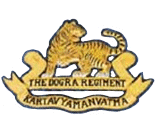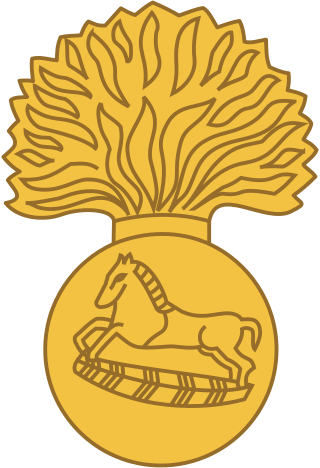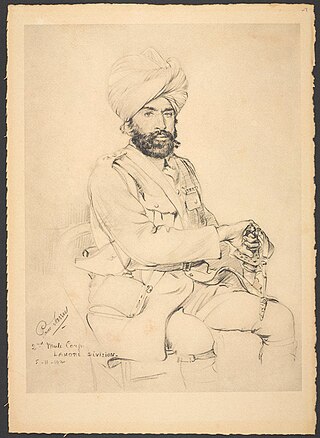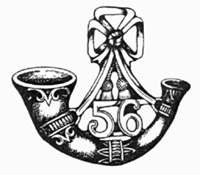Related Research Articles

The Dogra Regiment is an infantry regiment of the Indian Army. The regiment traces its roots directly from the 17th Dogra Regiment of the British Indian Army. When transferred to the Indian Army like its sister regiments, the numeral prefix was removed. Units of the Dogra Regiment have fought in all conflicts that independent India has been engaged in, making it one of the most prestigious and most decorated regiments of the Indian Army.

The Grenadiers is an infantry regiment of the Indian Army, formerly part of the Bombay Army and later the pre-independence British Indian Army, when the regiment was known as the 4th Bombay Grenadiers. It has distinguished itself during the two world wars and also since the Independence of India. The regiment has won many battle honours and gallantry awards, and is considered to be one of India's most decorated regiments with three Param Vir Chakra awardees in three different conflicts.

The 2nd Queen Victoria's Own Rajput Light Infantry, commonly shortened to 2nd Rajputs, was a regiment of the British Indian Army. Raised in 1798, it was amalgamated with five other Rajput regiments in 1922.

The Indian Army, also called the British Indian Army, was involved in World War I as part of the British Empire. Over one million Indian troops served overseas, of whom 62,000 died and another 67,000 were wounded. In total at least 74,187 Indian soldiers died during the war.
The 39th Garhwal Rifles was an infantry regiment of the British Indian Army.

The 7th (Meerut) Division was an infantry division of the British Indian Army that saw active service during World War I.

The 3rd (Lahore) Division was an infantry division of the British Indian Army, first organised in 1852. It saw service during World War I as part of the Indian Corps in France before being moved to the Middle East where it fought against troops of the Ottoman Empire.
The 16th Indian Division was an infantry division of the Indian Army during the First World War. It was formed in December 1916, during the First World War. It was the only war formed division of the British Indian Army that was not sent overseas, instead it was sent to guard the North West Frontier. The division took over the responsibilities of the 3rd Lahore Divisional Area when it was disbanded in May 1917.

The 11th Rajputs was an infantry regiment of the Bengal Army and later of the British Indian Army. They could trace their origins to 1825, when they were the 2nd Extra Battalion, Bengal Native Infantry. In 1828, they were renamed the 70th Bengal Native Infantry and a number of changes in name followed - the 11th Bengal Native Infantry 1861–1885, the 11th Bengal Infantry 1885–1897, the 11th (Rajput) Bengal Infantry 1897–1901, the 11th Rajput Infantry 1901–1903. Finally in 1903, after the Kitchener reforms of the Indian Army - the 11th Rajputs.

The 29th Punjabis was an infantry regiment of the British Indian Army. It was raised in 1857, as the 21st Regiment of Punjab Infantry. It was designated as the 29th Punjabis in 1903 and became 10th (Training) Battalion of 15th Punjab Regiment in 1922. In 1943, it was converted into the 15th Punjab Regimental Centre. In 1947, the 15th Punjab Regiment was allocated to the Pakistan Army. In 1956, the 1st, 14th, 15th and 16th Punjab Regimental Centres where amalgamated to form the Punjab Regimental Centre.

The 25th Punjabis was an infantry regiment of the British Indian Army. It was raised in 1857, as the 17th Regiment of Punjab Infantry. It was designated as the 25th Punjabis in 1903 and became 1st Battalion 15th Punjab Regiment in 1922. In 1947, it was allocated to the Pakistan Army, where it continues to exist as 9th Battalion The Punjab Regiment.

The 28th Punjabis were an infantry regiment in the British Indian Army. It was raised in 1857, as the 20th Regiment of Punjab Infantry. It was designated as the 28th Punjabis in 1903 and became 4th Battalion 15th Punjab Regiment in 1922. In 1947, it was allocated to the Pakistan Army, where it continues to exist as 12th Battalion The Punjab Regiment.

The 56th Punjabi Rifles (Frontier Force) was an infantry regiment of the British Indian Army. It was raised in 1849 as the 2nd Regiment of Punjab Infantry. It was designated as the 56th Punjabi Rifles (Frontier Force) in 1906 and became 2nd Battalion 13th Frontier Force Rifles in 1922. In 1947, it was allocated to the Pakistan Army, where it continues to exist as 8th Battalion The Frontier Force Regiment.
The 37th Dogras was an infantry regiment of the British Indian Army. The regiment could trace its origins to 1887, when it was raised as the 37th (Dogra) Bengal Infantry.

The 38th Dogras were an infantry regiment of the British Indian Army. They could trace their origins to 1858, when they were raised as an irregular unit named the Agra Levy. In 1864 the regiment was incorporated into the regular line infantry of the Bengal Army, under the title of the 38th (Agra) Regiment Bengal Native Infantry.

The 45th Rattray's Sikhs was an infantry regiment of the British Indian Army. They could trace their origins to the 1st Bengal Military Police Battalion raised in April 1856, at Lahore, by Captain Thomas Rattray originally consisting of a troop of 100 cavalry and 500 infantry. The initial class composition of the troops was 50% Sikhs and 50% Dogras, Rajputs and Mussulmans (Muslims) from the Punjab and the North-West Frontier. It is said that he went through the villages challenging men to wrestle with him on the condition that they had to join up. Whatever the case, the regiment was raised and trained and developed as an elite corps, which soon saw action in Bihar in the Sonthal 'parganas'. After sterling service in Bihar, Bengal and Assam, and during the 1857 Mutiny, the cavalry portion was eventually disbanded in 1864 and the infantry section was taken into the line of Bengal Native Infantry as the '45th Native Regiment of Infantry'.
The 67th Punjabis were an infantry regiment of the British Indian Army. They could trace their origins to 1759, when they were raised as the 8th Battalion Coast Sepoys.
The 94th Russell's Infantry were an infantry regiment of the British Indian Army. They could trace their origins to 1813, when they were raised as the 1st Battalion of the Russell Brigade for the Princely state of Hyderabad. Until 1853, the regiment was part of the Nizam of Hydrabad's Army then after signing of a treaty with the then Governor General of India, The Nizam's Contingent was renamed as the Hyderabad Contingent and became part of the regular Indian Army.
The 41st Indian Brigade was an infantry brigade of the British Indian Army that saw service with the Indian Army during the First World War. It served in the Mesopotamian Campaign on the Euphrates Front throughout its existence. It was not reformed for the Second World War.
The 35th Indian Brigade was an infantry brigade of the British Indian Army that saw active service with the Indian Army during the First World War. It took part in the Mesopotamian campaign and was disbanded shortly after the end of the war. It was not reformed for the Second World War.
References
- ↑ "Researching the Lives and Service Records of First World War Soldiers - 41st Dogras". researchingww1.co.uk. Retrieved 6 June 2023.
- ↑ Sumner p.15